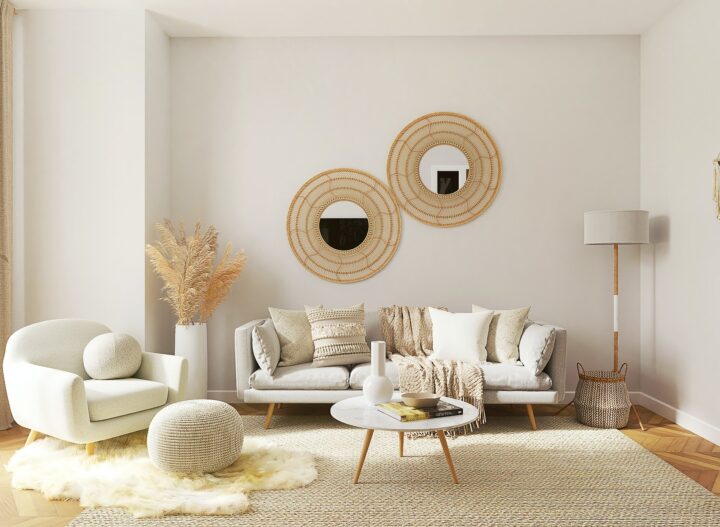How an Interior Design Course Can Change Your Perception of Living Space
The link between psychology and interior design has gained decent attention over the years. A poorly designed bedroom can have an opposing from relaxing effect. Some rooms feel welcoming and warm, while others might have a negative atmosphere.
If you are considering taking an interior design course, this might be an interesting concept to explore.

Benefits of Choosing Interior Design
Whether you are a college student or a professional looking into new opportunities, interior design is a great choice. It is an interesting field that helps to know more about your living conditions and promotes better well-being for yourself and others. And it offers significant career opportunities.
However, if you are already taking several classes in college, you might wonder whether you have time for another one. The college curriculum can be overwhelming with lectures, classes, and numerous assignments.
Students often struggle with deadlines and endless essays. Luckily, one can order edit my paper service to save a lot of time and make sure the paper is excellent. Professional academic writers can nail any type of college assignment in the shortest time.
Also, editing by experts offers an objective perspective and valuable advice. Also, professional academic writing platforms offer writing and proofreading services. In any case, it is a great opportunity to take some stress off your shoulders and maintain good grades.
Such consideration should not stop one from pursuing their passion. There are various ways to learn interior design – in college, through online courses, with manuals, tutorials, etc.
The benefits of learning interior design are
- Creativity, imagination, and innovative thinking boost;
- Acquisition of new skills that will be handy for personal and professional use;
- A better understanding of spaces;
- Comprehension of the psychology of interior design;
- Career prospects;
- Opportunity to work on engaging and exciting projects;
- Ability to make a positive change in one’s life.
Interior design is much more than simply choosing furniture and wallpaper. The environment people live and work in impacts their mood and well-being directly.
Particularly, the psychology of space studies the connection between environment and behavior, mood, and physical and mental well-being.
So learning interior design will not only help to do on-budget home renovations but also will give one a better perspective on living space as a whole.
The Way Interior Design Shapes Perception of Space
Even if you are a beginner in this field, you have experienced the influence of interior design on you. It happens because of a combination of several factors, namely:
- Basic design principles (harmony, symmetry, balance, shapes);
- Lighting;
- Colors;
- Layout;
- Living elements;
- Textures;
- Acoustics, etc.
All of them work together to create a particular atmosphere. Some rooms are ideal for relaxation; others boost motivation and energy. And it is not a coincidence but a result of the excellent work of designers.
Although this discussion has gained attention recently, it is nothing new. Some practices like Vastu Shastra (India) and Feng Shu (China) have existed for thousands of years. However, now scientists can explore these effects with new technology, neuroscience, and large-scale research. Check out some designs proposed by Helen Coulston on her YouTube channel and see for yourself how you can implement different techniques and styles.
So how exactly do these factors influence our perception of living space? Let’s get into some detail.
Color Palette
It is probably one of the most commonly-known factors on the list. Everyone has heard that different colors might affect people’s behavior. And it is true. The proper usage of the available palette allows rich opportunities to achieve specific goals.
The tones, shades, and combinations impact the mood. They also might divide the space into sections, make it feel roomier, or the opposite. For example, pastels have a more calming effect, while bold colors are more energetic.
For instance, warm tones like red or orange might express passion and comfort. At the same time, when used wrong, they can stimulate aggression and anger. Cool tones like blue and green promote tranquility and peace. However, they might also evoke sadness or indifference. The slightest changes might have a positive or negative impact on the room’s perception.
The basic rules of color are:
- Red is warm and brings heat: it is powerful, energetic, and sometimes aggressive;
- Yellow is warm and associated with light, sun, energy, and creativity;
- Green is cool and has a soothing effect. Natural shades calm people down;
- Blue is associated with nature, the sky, or the ocean. It feels fresh, peaceful, and tranquil;
- Purple is historically regarded as a luxurious one (it was very expensive to make in previous centuries). It can be soft as a pastel shade but also irritating in bold shades;
- Gray is neutral and balanced but can also feel unwelcoming;
- Brown is a natural color that can add warmth but also might be dull or gloomy;
- Black is not often used as it might be associated with death in western cultures. But it can add accents and sophisticated designs;
- White is very neutral. It adds brightness and cleanliness.
In interior design courses, you’ll learn about color theory and how to combine them properly to achieve a particular vibe.
Layout
The overall outlook depends on the furniture, accessories, windows, and the way they are placed. It strikes one when they enter a room. Any space can be transformed for various needs. It can be a room for work, leisure, or sleeping.
Interior design is not only about aesthetics but also functionality. Everything serves a purpose, and every little detail is important.
Lighting
This is another crucial factor that can add value to housing or destroy its atmosphere. Light sets the mood and impacts the brain: dim light might be relaxing and soothing but also dull. Bright light, in contrast, might promote energy, focus, and motivation. However, it can also feel out of place when used in a bedroom, for instance.
Lighting can accentuate specific features, break the room into zones, and compliment the architecture. Every separate space needs a unique approach to lighting. But the general rule is that natural light promotes better mood, sleep, creativity, and productivity.
Natural Elements and Textures
Another way to make a space feel more welcoming is the introduction of natural elements and materials. Humans have a connection with nature, and something simple like indoor plants can make the living place much more suitable.
The natural environment has a relaxing impact and restorative nature. In interior design, it means focusing on natural light, plants, décor pieces, water features, and natural materials.
Personality
Have you ever walked into a space and thought that it has no personality in it? It feels neutral and forgettable. Such neutral interiors are often used in the promotion of new buildings or apartments as they seem to suit everyone.
But they lack the very important factor – something that makes this space yours. The choice of artworks and décor say something about you to others. Also, it makes a living environment welcoming as it feels more natural to your needs.
In Summary
Interior design courses help people learn a lot about the living environment and how it affects humans. Although some might not think about it, the place we live or work in has a major influence on our mood, behavior, and overall well-being.
It is a combination of many factors and details that can make you feel at home. But when done wrong, it can have the opposite effect.


